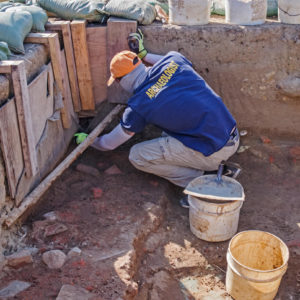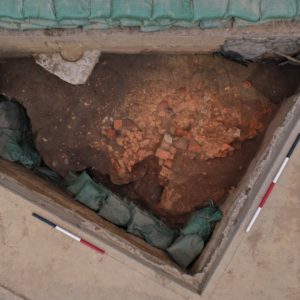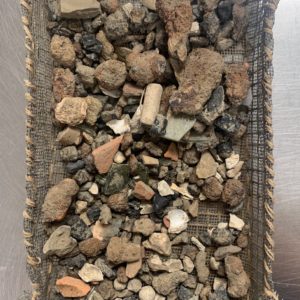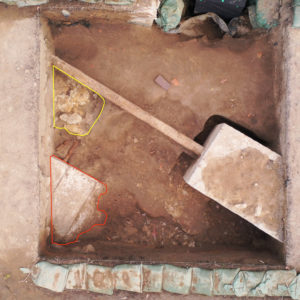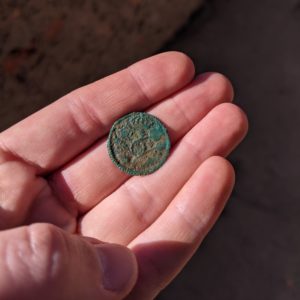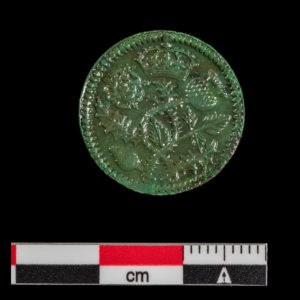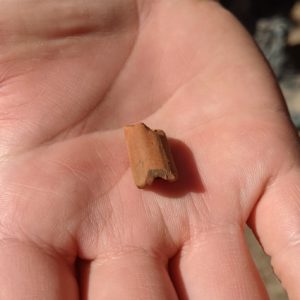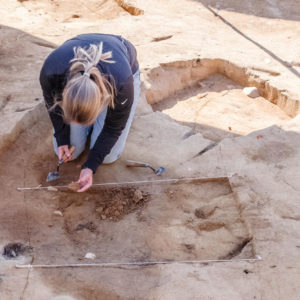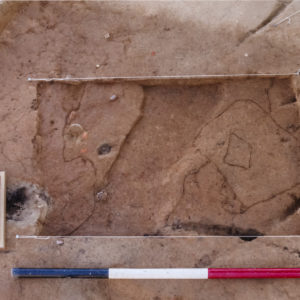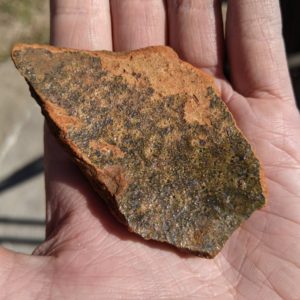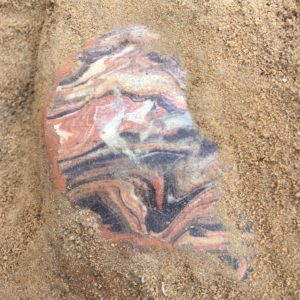Over the past few weeks the team has made a great deal of progress. The recent warm temperatures have made for perfect excavation weather, and the staff is happy to be starting spring. The park has also reopened to the public, and we have enjoyed seeing and talking to visitors once again.
Down at our Seawall excavations, we opened a small portion of a new test unit to further investigate the dry-laid brick foundation that was discovered a few months ago. We are still trying to understand exactly what the foundation was for, but the current hypothesis is that it was part of a set of stairs. In the next few weeks, we will be removing the remaining soil near the foundation, to see if they are indeed stairs.
The layers atop and around the foundation are historic, and possibly date to the 17th century. As a result, the dirt removed is being water-screened. This means that a hose is used to push the soil through an eighth-inch screen and then a window screen to catch any objects, such as fish bones, lead shot, fish scales, beads, or any other small artifacts that would otherwise fall through our usual quarter-inch screens. Using water helps us push the soil through smaller screens while partially cleaning artifacts, making them easier to spot throughout the process. Luckily, since the weather has been nice, quite a bit of water-screening has been done, yielding a good number of artifacts. After analysis, these artifacts will help us narrow down the date range for the layer excavated.
In the middle Seawall unit, some very interesting finds have been coming out of a modern clay feature. This feature may be related to the Seawall and its construction in the early 20th century. The reason older artifacts are found in a modern feature is because the historic layers below were disturbed and mixed in with the modern material. The coolest find to come out of this feature was a King’s Touch Token. This particular token dates to the early 17th century, most likely from King James I reign, and is one-sided, with the face containing a rose and thistle crossed below a crown. The same token has been found at multiple other locations around the fort.
These items were normally given out as souvenirs at a King’s touch ceremony (where the king would show his “divine touch” by healing people). However, the ones found at Jamestown may have a different story, not unlike many of the other artifacts we encounter. The lab staff here at Jamestown recently put together a detailed examination of these tokens and their significance. Check it out here: “King’s Touch Token.”
At our other excavation south of the Memorial Church we have begun small tests into a few of the ditches. As of now we have three: two cutting across individual ditches and one across the conjunction of two ditches. Each of these tests will give us an idea of how the individual ditches were dug, how long they were in use, and when they were filled in. Some of the ditches actually intersect and cut one another, giving us an idea of which ditches came first and how the landscape changed over time. These ditches were also dug into Jamestown Island’s subsoil, which is a natural orange clay deposit. This sterile clay often provides a sharp contrast to archaeological features, making it easier for us to identify and track cultural activity in a space.
Since our tests have just begun, there are not too many artifacts to show off. So far, we have recovered a couple pieces of redware, a small piece of borderware, and some small pieces of wine glass. After we finish our originally laid section of Ditch JR4614, we may expand it outward to the very end of the ditch, where a piece of Italian marbled slipware is visible in the fill. Though we can relatively date these ditches with each other based on which was dug most recently (the ditch that is not cut by others), the artifacts recovered will help us give each ditch a more specific date.
related images
- Archaeologist Ryan Krank cleaning the test unit at the Seawall
- A drone shot of the Seawall units since the “pizza slice” has been taken down to the same level as JR4550
- Small artifacts found by water-screening through intact historic layers at the Seawall
- The middle unit at the Seawall where interesting historic artifacts are being found in modern fill. The area being excavated (yellow) is likely related to the Seawall (red).
- The “King’s Touch” token found in the 20th-century context at the Seawall
- A closer image of the “King’s Touch” token after it was brought into the lab
- A locally-made pipe stem fragment recovered from the same 20th-century Seawall context
- The three ditch tests that have been laid out and are currently being excavated
- Archaeologist Caitlin Delmas testing into Ditch JR4614 at the Ditch 8 excavations
- A record shot taken of the test across Ditch JR4614 once the first layer of fill was removed. A post hole also appeared in the fill, not visible before beginning the section
- Archaeologist Natalie Reid excavating a test into Ditch JR4612
- One of the sherds of redware, the glaze still visible, recovered from Ditch JR4614
- The sherd of Italian Marbled Slipware located just beyond our Ditch JR4614 section



